When bringing people together to solve problems with design thinking, there may be more benefits to going remote than you think.
This is an InnovationTraining.org guest article by Sprintbase.
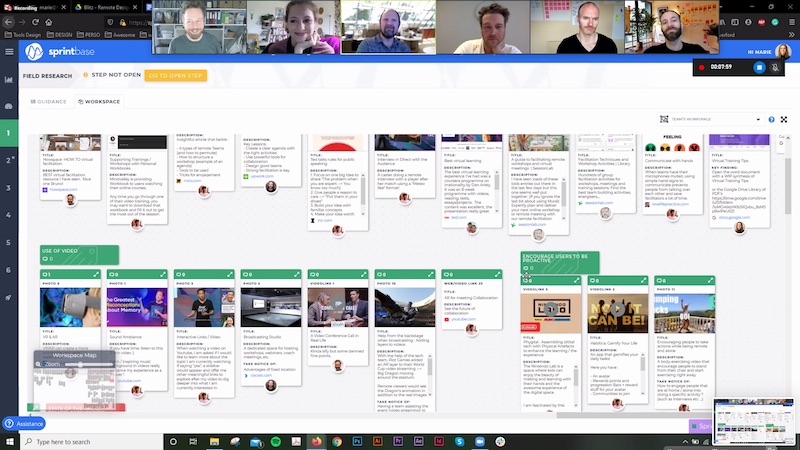
Face-to-face design thinking workshops can be amazing. There is a certain energy, human connection and buzz that is pretty hard to reproduce in a virtual format. But since we created Sprintbase in 2016 – a platform that enables remote teams to solve problems with design thinking – we’ve learned a lot about what it takes to create new kinds of virtual experiences that can be just as great in their own right.
Rather than trying to replicate face-to-face experiences online, we focus on those things that are only possible in virtual environments. We’ve found that with the right approach and with the right tools, teams working remotely can produce more robust, actionable solutions in less time than many of their face-to-face counterparts.
In this article, we look at five of the most significant advantages of doing design thinking remotely and how to achieve them:
- Involving all the right people
- Greater team and individual creativity
- Increased accountability
- Faster feedback and iteration
- Immediate, more tangible, actionable output
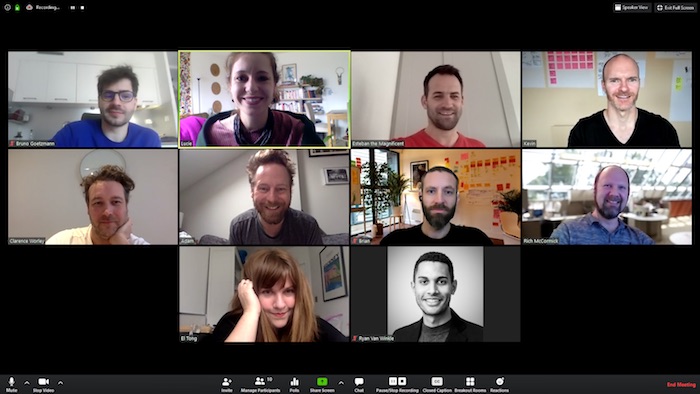
1. Involving all the right people
Complex problems often require a multidisciplinary team to solve them. Getting everyone together in-person, especially for large global organizations, can be costly and logistically challenging. Going remote helps here.
Once we’re virtual, we can begin to challenge assumptions about who should be involved, in what capacity, and for what duration. For instance, for time and cost reasons, a face-to-face workshop generally just brings one fixed group of people together for the entire time. This needn’t be the case when we go remote.
On virtual sprints, we’ve seen subject matter experts join only for the field research phase, and colleagues new to the challenge invited to provide fresh input during ideation. We’ve also seen real customers invited to provide feedback on digital assets being created in real time.
The result is greater diversity of input, which any design professional can tell you is a critical ingredient in achieving innovative results.
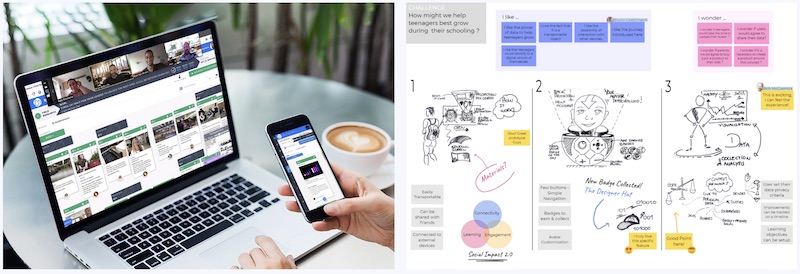
2. Maximized team and individual creativity
The fast-paced, collaborative buzz of an in-person workshop can be exhilarating. Teams spend most of their time working together in real-time, relying on the collision of ideas and generally tapping into the creative energy that comes from bringing people together.
However, for many people, their best work happens when they’ve had time to reflect on the challenge, independently from the group. There’s limited time to do this in a face-to-face setting. There’s also the constant risk of “groupthink” setting in – where people inadvertently start converging around a single direction, when they should be diverging around many different possible directions and ideas.
We designed Sprintbase to tap into both the creative synergies that come from everyone working together in real-time (synchronous working) in digital workspaces, and the novel insights and ideas that come from individual reflection, created independently from the group (asynchronous working).
When remote teams use asynchronous approaches, we see a far greater variety of ideas and perspectives enter the mix. And when it comes time to converge on ideas, synthesize findings, or jointly build a prototype, synchronous working reaps the best results.
Using both approaches helps teams take design thinking projects to the next level – and is far more practical with the time and tools available when working remotely.
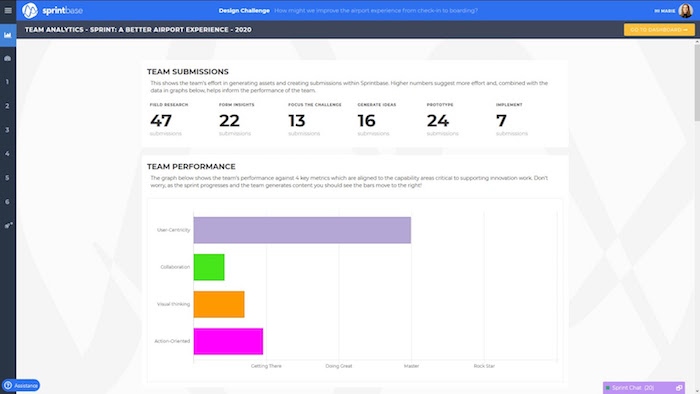
3. Increased accountability
In a face-to-face workshop, there are always some participants who instinctively step into team leadership roles (requested or otherwise), and those that spend a lot of time checking emails and raiding the pastry table. However, everyone is there in one place, and often under the helpful guidance of a facilitator. So accountability must surely be easier to maintain in-person, right?
Well, not always. It is true that with remote working, these patterns emerge as well. Some people carry the burden and in the worst cases others disappear completely.
We built Sprintbase to help solve this problem. Team as well as individual performance analytics are visible to all team members. At a glance, it is clear who is doing what, how much time is being spent, and even how effective they are at applying core design thinking mindsets of collaboration, user-centricity, and visual thinking.
At each stage in the process, it’s clear to the team who we are “waiting on” to submit content, vote, or provide feedback.
This visibility creates a helpful social dynamic, which ensures the group as a whole can identify bottlenecks, agree how to change team accountabilities, and move forward together.
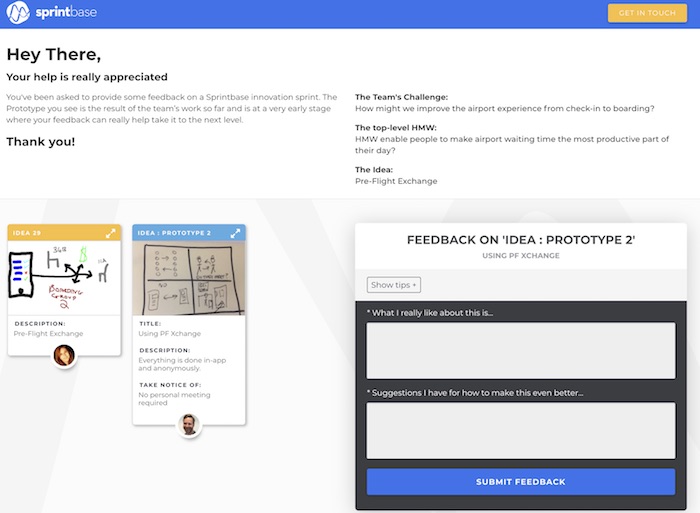
4. Faster feedback and iteration
At the end of a workshop, it is not uncommon to walk away with concrete actions to get feedback from users and other stakeholders on the resulting ideas and prototypes. This is definitely good practice, but there is often a lag between leaving the workshop and getting feedback, which can really stall momentum. When working remotely, this can be sped up dramatically, reaching more diverse sets of feedback providers than would ever be possible face-to-face.
After working with one of the largest brewing companies in the world, we heard that it would be great to go back to the restaurant, theatre and bar owners who were initially interviewed during the field research stage of the process to get their feedback on the initial prototypes that had emerged.
To facilitate this, we introduced a “Get Feedback” function in Sprintbase that allows the creator of a prototype to automatically send anyone (customer, colleague, sponsor, etc) a link to just that idea, and the prototype for which they want some feedback.
Feedback providers enter what they like, as well as what they wish could be better into a simple form included in the linked feedback page. This feedback is then automatically logged within that prototype in Sprintbase to enable the team to rapidly incorporate it in future iterations.
For the brewery project, over 20 unique feedback submissions were received on six different prototypes by the team in less than a week.

5. More tangible, actionable output
Finally, and perhaps most critically, there is the output. The answer to: What have we achieved?
At the end of a two-three day workshop, we’re left with a mountain of post-it notes and sketches on flipcharts. And of course there will be genius in there, but extracting it is a manual process, and invariably things get lost. Not just because sticky notes fell off a whiteboard, but because there is often little record of the teams’ conversations that led to these ideas, and prototypes are often of such low fidelity that they are difficult to interpret after the fact.
But when ideas were created digitally to begin with, they are immediately of higher fidelity, and come with a supporting description. Rough sketches can be photographed and annotated. In the same amount of time or less, slick digital assets can be created incorporating images, shapes, drawings and other media.
When you go remote using Sprintbase, every observation, insight, ‘How might we..?’ question, idea, prototype and implementation is captured in a detailed PDF report of the team’s entire journey, which you can download and share at any time.
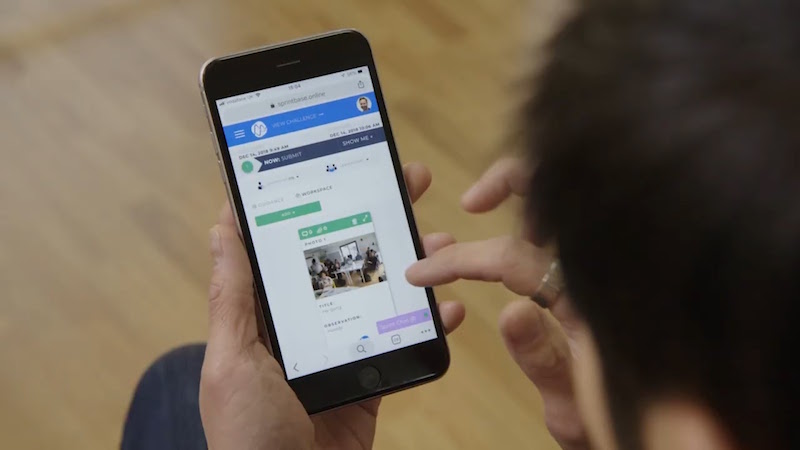
Embrace the benefits going virtual brings
For many, remote working has been the norm for some time, but for others it’s become a sudden necessity, and has made for a challenging change.
But our experience shows us that, when it comes to design thinking, embracing the unique advantages of going virtual proves hugely beneficial for organizations.
Remote working allows more people to get involved in different projects, save time and money, and reduce environmental footprint. It also can also enable project teams to achieve more in less time, produce more tangible and actionable output, and pull together a compelling story that will help them secure buy-in for their ideas.
Face-to-face working will always have a hugely valuable role to play – in innovation and our wider working lives. But embracing remote design thinking now will enable more organizations to tackle more challenges, solve more problems and engage more people regardless of where they are based.
This guest article is from Sprintbase. Visit sprintbase.io to find out more and get your free trial, or email [email protected] to discuss how you can use the platform to do design thinking remotely with your team.
Want to amplify your innovative impact in just 15 minutes? The Innovation Impact™ assessment is a new academic research-based learning and assessment tool that helps teams quickly identify the specific behaviours that will lead to improved innovation results as well as tap into the diversity of strengths on their team. Click here to take the assessment.